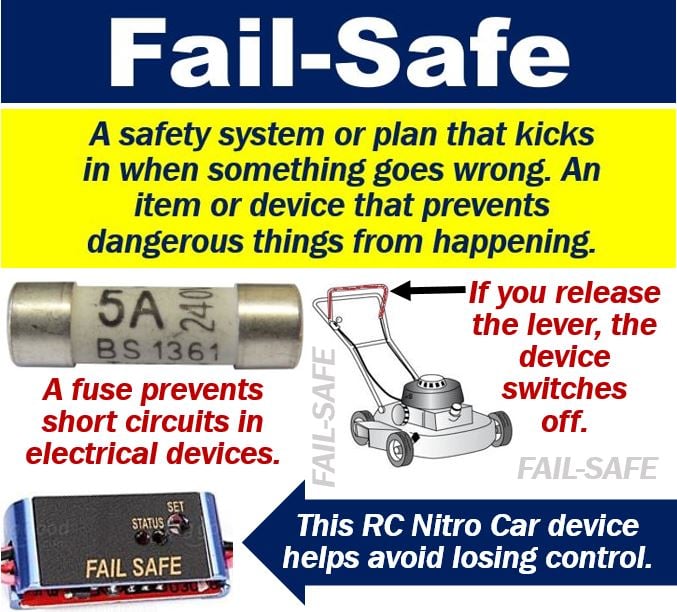A Fail-Safe machine resorts to a safe mode if anything goes wrong. This means that nothing dangerous can happen, i.e., it fails safely. We can use the term for physical machines and also abstract things. Computer programs and systems, for example, are abstract.
Noun or adjective
The term exists as a noun or adjective.
Noun
In the sentence below, the term is a noun:
“The system has a fail-safe. Whenever things go wrong, or there is a risk of danger, it shuts down immediately.
Adjective
In the sentence below, the term is an adjective:
“This machine has a fail-safe mechanism. If the person operating it dies, loses consciousness, or cannot control it for any reason, it shuts down.”
For example:
“There was a fail-safe mechanism in place to override the controls in case of a malfunction.”
Fail-safe and insurance
Sometimes, you won’t get insurance cover for a machine or piece of equipment if it does not have a fail-safe.
Insurance refers to paying money to safeguard against the risk of damage, fire, flooding and other adverse events. Human injury or loss of life, for example, are also adverse events.

Fail-safe – dead man’s switch
Many machines have levers or switches that the operator must hold for them to work. If the operator lets go, they automatically switch off.
Lawnmowers
Lawnmowers have a lever that you must hold tight. If you let go, the lawnmower stops working. It is there to protect you.
Let’s suppose you were mowing the lawn and then suddenly fainted. You would let go of the lever, and subsequently, the machine would stop. Therefore, the rotor blades would not be a danger to you or anybody else.
We call that horizontal lever a ‘dead man’s switch.’
Trains
Many trains have a dead man’s switch. This means that if the driver becomes incapacitated, the train will slow down and stop.
This fail-safe mechanism protects the passengers, driver, and other trains. If the railway line crosses a road, it also protects pedestrians and road vehicles.
Chainsaws
Chainsaws often have a dead man’s switch; releasing the handle immediately stops the blade, preventing potential injury.
Jet Skis
Modern jet skis use a dead man’s switch that cuts the engine if the rider falls off, preventing the craft from straying.
Autonomous vehicles
Autonomous vehicles, i.e., driverless vehicles, will become standard modes of transport soon. However, it is important that they do not crash into other vehicles, buildings, objects, or pedestrians.
The GATEway autonomous shuttle in London, for example, has been designed to be safe and fail-safe, say its creators.
GATEway stands for the Greenwich Automated Transport Environment project.
A misunderstood term
According to Coding the Architecture, fail-safe is a term that many people and even dictionaires use incorrectly. Most lay people, i.e., not engineers or architects, mistakenly think it means something will not fail.
In fact, the whole point of having it is because we expect the system or device to fail eventually. However, when it does, it will do so safely.
Coding Architecture provides us with some examples of fail-safe devices:
“Classic examples include the brakes on trains that engage when they fail and ratchet mechanisms in lifts/elevators so they can’t drop if the cable breaks.”
“Well engineered physical devices will state their Mean Time Between Failure (MTBF) and define how they can fail and what happens when they do.”
A system that continues going when things go wrong is a fail soft system. When there is a malfunction, a fail soft system shuts down all non-essential functions. Therefore, the user can still use it, but only for basic functions.
Fail-safe vs. failover
Do not confuse the term with ‘failover.’
Failover refers to the constant ability to function properly or provide a service. If something goes wrong, the system seamlessly switches over to a backup.
When something has a failover mechanism, it can carry on operating even when there is a breakdown or malfunction.
In medical equipment, fail-safe and failover designs are essential, ensuring that life-support machines maintain vital functions even during technical failures.
Video – What is Fail-Safe
This interesting video presentation, from our sister channel on YouTube – Marketing Business Network, explains what ‘Fail-Safe’ means using simple and easy-to-understand language and examples.
